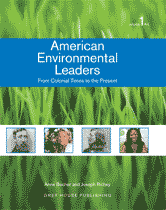The Founding Fathers on the Care of the Land (1793, 1818)
From The Environmental Debate: A Documentary History
"Three of the first four U.S. presidents—George Washington, Thomas Jefferson, and James Madison—were Virginia planters who devoted a great deal of thought, study, and effort to the development of techniques for making their land more productive. While they carefully rotated crops and fields, they rejected the use of high-priced fertilizers until rising land prices made such expenditures practical. They were all active members of the American Philosophical Society, one of whose primary goals was the furtherance of scientific agriculture."



